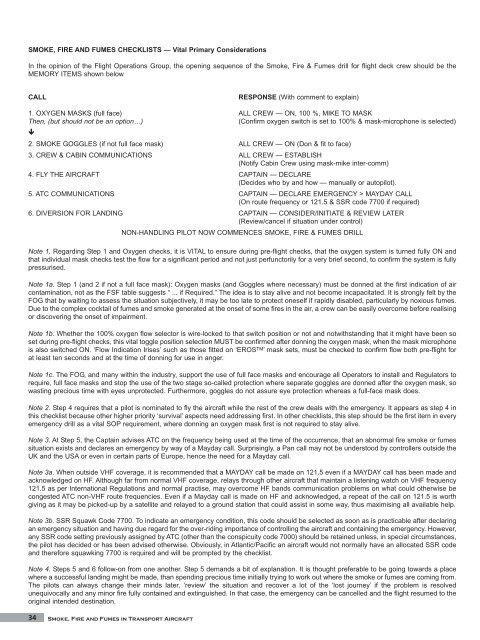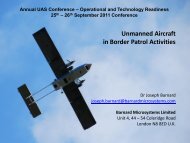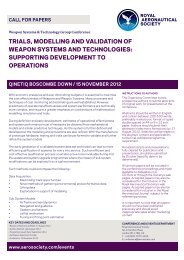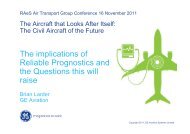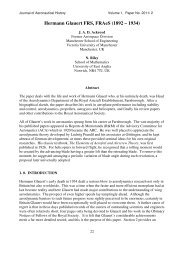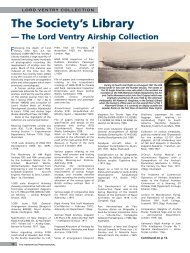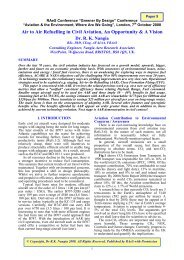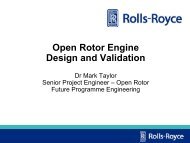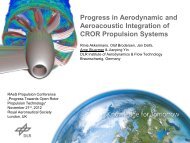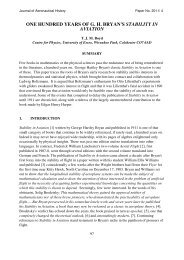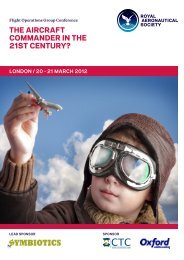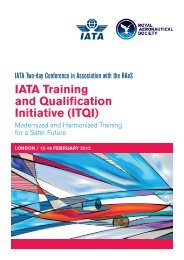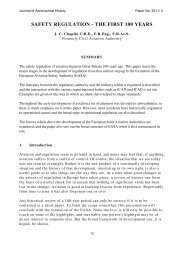Smoke, Fire and Fumes in Transport Aircraft - Royal Aeronautical ...
Smoke, Fire and Fumes in Transport Aircraft - Royal Aeronautical ...
Smoke, Fire and Fumes in Transport Aircraft - Royal Aeronautical ...
Create successful ePaper yourself
Turn your PDF publications into a flip-book with our unique Google optimized e-Paper software.
SMOKE, FIRE AND FUMES CHECKLISTS — Vital Primary Considerations<br />
In the op<strong>in</strong>ion of the Flight Operations Group, the open<strong>in</strong>g sequence of the <strong>Smoke</strong>, <strong>Fire</strong> & <strong>Fumes</strong> drill for flight deck crew should be the<br />
MEMORY ITEMS shown below<br />
CALL RESPONSE (With comment to expla<strong>in</strong>)<br />
1. OXYGEN MASKS (full face) ALL CREW — ON, 100 %, MIKE TO MASK<br />
Then, (but should not be an option…) (Confirm oxygen switch is set to 100% & mask-microphone is selected)<br />
<br />
2. SMOKE GOGGLES (if not full face mask) ALL CREW — ON (Don & fit to face)<br />
3. CREW & CABIN COMMUNICATIONS ALL CREW — ESTABLISH<br />
(Notify Cab<strong>in</strong> Crew us<strong>in</strong>g mask-mike <strong>in</strong>ter-comm)<br />
4. FLY THE AIRCRAFT CAPTAIN — DECLARE<br />
(Decides who by <strong>and</strong> how — manually or autopilot).<br />
5. ATC COMMUNICATIONS CAPTAIN — DECLARE EMERGENCY > MAYDAY CALL<br />
(On route frequency or 121.5 & SSR code 7700 if required)<br />
6. DIVERSION FOR LANDING CAPTAIN — CONSIDER/INITIATE & REVIEW LATER<br />
(Review/cancel if situation under control)<br />
NON-HANDLING PILOT NOW COMMENCES SMOKE, FIRE & FUMES DRILL<br />
Note 1. Regard<strong>in</strong>g Step 1 <strong>and</strong> Oxygen checks, it is VITAL to ensure dur<strong>in</strong>g pre-flight checks, that the oxygen system is turned fully ON <strong>and</strong><br />
that <strong>in</strong>dividual mask checks test the flow for a significant period <strong>and</strong> not just perfunctorily for a very brief second, to confirm the system is fully<br />
pressurised.<br />
Note 1a. Step 1 (<strong>and</strong> 2 if not a full face mask): Oxygen masks (<strong>and</strong> Goggles where necessary) must be donned at the first <strong>in</strong>dication of air<br />
contam<strong>in</strong>ation, not as the FSF table suggests “ ... if Required.” The idea is to stay alive <strong>and</strong> not become <strong>in</strong>capacitated. It is strongly felt by the<br />
FOG that by wait<strong>in</strong>g to assess the situation subjectively, it may be too late to protect oneself if rapidly disabled, particularly by noxious fumes.<br />
Due to the complex cocktail of fumes <strong>and</strong> smoke generated at the onset of some fires <strong>in</strong> the air, a crew can be easily overcome before realis<strong>in</strong>g<br />
or discover<strong>in</strong>g the onset of impairment.<br />
Note 1b. Whether the 100% oxygen flow selector is wire-locked to that switch position or not <strong>and</strong> notwithst<strong>and</strong><strong>in</strong>g that it might have been so<br />
set dur<strong>in</strong>g pre-flight checks, this vital toggle position selection MUST be confirmed after donn<strong>in</strong>g the oxygen mask, when the mask microphone<br />
is also switched ON. ‘Flow Indication Irises’ such as those fitted on ‘EROS TM’ mask sets, must be checked to confirm flow both pre-flight for<br />
at least ten seconds <strong>and</strong> at the time of donn<strong>in</strong>g for use <strong>in</strong> anger.<br />
Note 1c. The FOG, <strong>and</strong> many with<strong>in</strong> the <strong>in</strong>dustry, support the use of full face masks <strong>and</strong> encourage all Operators to <strong>in</strong>stall <strong>and</strong> Regulators to<br />
require, full face masks <strong>and</strong> stop the use of the two stage so-called protection where separate goggles are donned after the oxygen mask, so<br />
wast<strong>in</strong>g precious time with eyes unprotected. Furthermore, goggles do not assure eye protection whereas a full-face mask does.<br />
Note 2. Step 4 requires that a pilot is nom<strong>in</strong>ated to fly the aircraft while the rest of the crew deals with the emergency. It appears as step 4 <strong>in</strong><br />
this checklist because other higher priority ‘survival’ aspects need address<strong>in</strong>g first. In other checklists, this step should be the first item <strong>in</strong> every<br />
emergency drill as a vital SOP requirement, where donn<strong>in</strong>g an oxygen mask first is not required to stay alive.<br />
Note 3. At Step 5, the Capta<strong>in</strong> advises ATC on the frequency be<strong>in</strong>g used at the time of the occurrence, that an abnormal fire smoke or fumes<br />
situation exists <strong>and</strong> declares an emergency by way of a Mayday call. Surpris<strong>in</strong>gly, a Pan call may not be understood by controllers outside the<br />
UK <strong>and</strong> the USA or even <strong>in</strong> certa<strong>in</strong> parts of Europe, hence the need for a Mayday call.<br />
Note 3a. When outside VHF coverage, it is recommended that a MAYDAY call be made on 121.5 even if a MAYDAY call has been made <strong>and</strong><br />
acknowledged on HF. Although far from normal VHF coverage, relays through other aircraft that ma<strong>in</strong>ta<strong>in</strong> a listen<strong>in</strong>g watch on VHF frequency<br />
121.5 as per International Regulations <strong>and</strong> normal practise, may overcome HF b<strong>and</strong>s communication problems on what could otherwise be<br />
congested ATC non-VHF route frequencies. Even if a Mayday call is made on HF <strong>and</strong> acknowledged, a repeat of the call on 121.5 is worth<br />
giv<strong>in</strong>g as it may be picked-up by a satellite <strong>and</strong> relayed to a ground station that could assist <strong>in</strong> some way, thus maximis<strong>in</strong>g all available help.<br />
Note 3b. SSR Squawk Code 7700. To <strong>in</strong>dicate an emergency condition, this code should be selected as soon as is practicable after declar<strong>in</strong>g<br />
an emergency situation <strong>and</strong> hav<strong>in</strong>g due regard for the over-rid<strong>in</strong>g importance of controll<strong>in</strong>g the aircraft <strong>and</strong> conta<strong>in</strong><strong>in</strong>g the emergency. However,<br />
any SSR code sett<strong>in</strong>g previously assigned by ATC (other than the conspicuity code 7000) should be reta<strong>in</strong>ed unless, <strong>in</strong> special circumstances,<br />
the pilot has decided or has been advised otherwise. Obviously, <strong>in</strong> Atlantic/Pacific an aircraft would not normally have an allocated SSR code<br />
<strong>and</strong> therefore squawk<strong>in</strong>g 7700 is required <strong>and</strong> will be prompted by the checklist.<br />
Note 4. Steps 5 <strong>and</strong> 6 follow-on from one another. Step 5 dem<strong>and</strong>s a bit of explanation. It is thought preferable to be go<strong>in</strong>g towards a place<br />
where a successful l<strong>and</strong><strong>in</strong>g might be made, than spend<strong>in</strong>g precious time <strong>in</strong>itially try<strong>in</strong>g to work out where the smoke or fumes are com<strong>in</strong>g from.<br />
The pilots can always change their m<strong>in</strong>ds later, ‘review’ the situation <strong>and</strong> recover a lot of the ‘lost journey’ if the problem is resolved<br />
unequivocally <strong>and</strong> any m<strong>in</strong>or fire fully conta<strong>in</strong>ed <strong>and</strong> ext<strong>in</strong>guished. In that case, the emergency can be cancelled <strong>and</strong> the flight resumed to the<br />
orig<strong>in</strong>al <strong>in</strong>tended dest<strong>in</strong>ation.<br />
34<br />
<strong>Smoke</strong>, <strong>Fire</strong> <strong>and</strong> <strong>Fumes</strong> <strong>in</strong> <strong>Transport</strong> <strong>Aircraft</strong>


